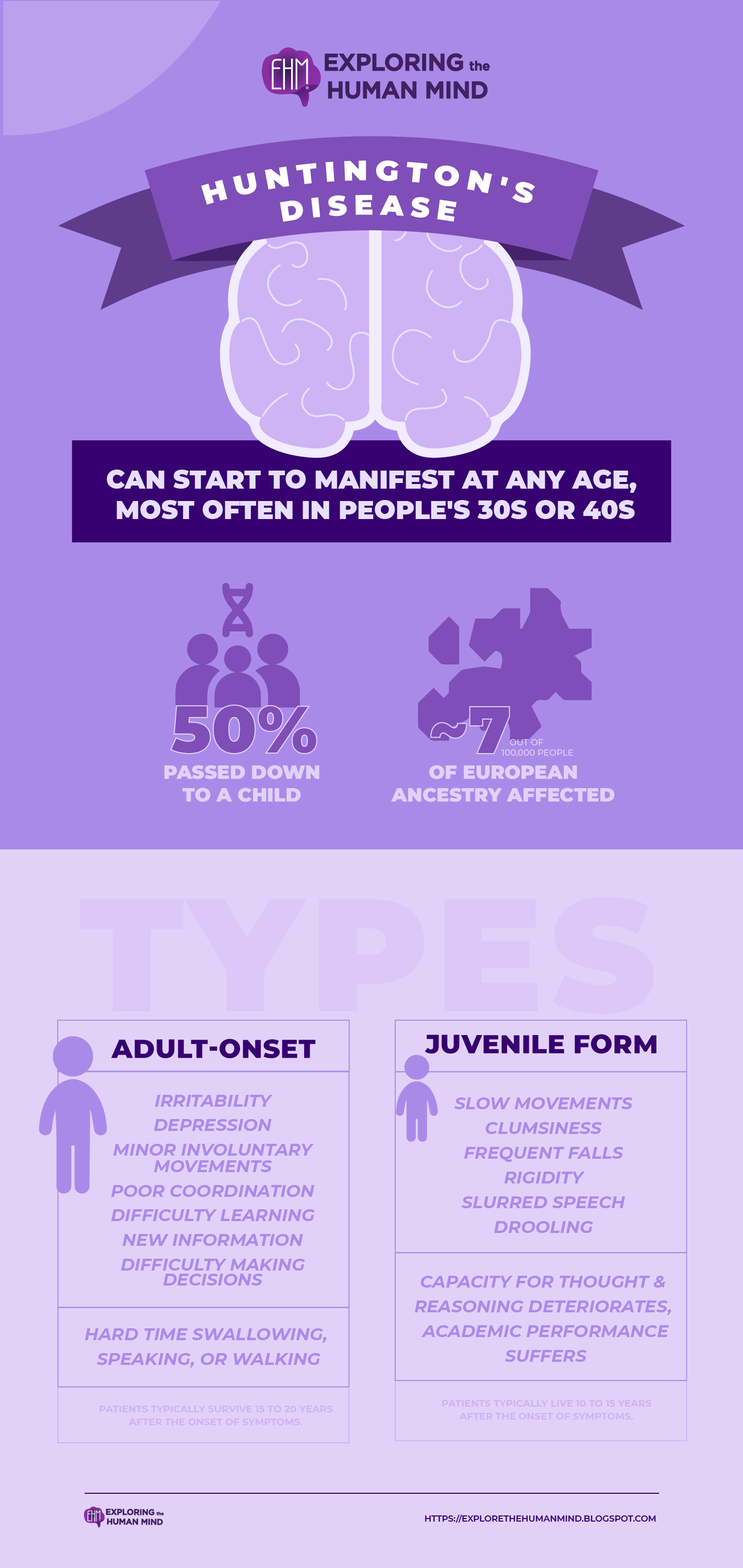Huntington’s disease
Huntington's disease will invariably manifest in people with the mutated gene, typically around middle age. The affected gene produces the huntingtin protein, whose purpose is unknown. However, the indirect pathway neurons in the striatum, especially those of the caudate nucleus, are killed by the gene's mutation.
Because it is characterized by constant, choreiform movements of the body (especially the limbs and face), Huntington's disease is also known as Huntington's chorea. Additionally, dementia is linked to the illness when it is advanced. Huntington's disease currently has no known cure or effective treatments.
The brain's nerve cells gradually degenerate as a result of this uncommon, inherited disease. Movement, thinking (cognitive), and psychiatric disorders are frequently symptoms of Huntington's disease, which has a significant impact on a person's functional abilities. An estimated 3 to 7 per 100,000 people of European ancestry are affected by the disease. Other populations, such as those of Japanese, Chinese, and African descent, seem to experience the disorder less frequently.
Types
Although symptoms of Huntington's disease can start to manifest at any age, they frequently do so in people in their 30s or 40s.
Adult-onset is he most prevalent form of this disorder, typically manifests in a person's 30s or 40. Irritability, depression, minor involuntary movements, poor coordination, difficulty learning new information, and difficulty making decisions are some of the early signs and symptoms. A common symptom of Huntington's disease is chorea, which are uncontrollable jerking or twitching movements. These movements intensify with the onset of the illness. People who are affected might have a hard time swallowing, speaking, or walking. A decline in thinking and reasoning skills as well as personality changes are other symptoms of this disorder. Adult-onset Huntington disease patients typically survive 15 to 20 years after the onset of symptoms.
A less common form of Huntington disease known as the juvenile form begins in childhood or adolescence.Additionally, it causes changes in the mind and emotions as well as movement issues. Slow movements, clumsiness, frequent falls, rigidity, slurred speech, and drooling are additional indicators of the juvenile form. As one's capacity for thought and reasoning deteriorates, academic performance suffers. Between 30% and 50% of children with this condition experience seizures. People with juvenile Huntington disease typically live 10 to 15 years after the onset of symptoms, with the disease progressing more quickly than in adults.
Symptoms of juvenile Huntington's disease
Younger individuals may experience a different onset and course of Huntington's disease than adults. The following issues frequently surface early in the course of the disease:
Behavioural changes:
- difficulty concentrating
- rapid, significant decline in student performance overall
- behavioural issues
Physical changes:
- muscles that are tight and rigid that affect gait, especially in young children
- slight involuntary movements, such as tremors
- falling down a lot or being clumsy
- seizures
Diagnosis
To determine if a patient has HD, doctors typically use a combination of tests and other data. These consist of genetic testing, lab and neurological tests, brain imaging, and medical history.
Treating HD
HD cannot be stopped or reversed with medication, but some of the symptoms can be managed:
- Tetrabenazine and Deuterabenazine are medications that can treat HD-related chorea
- Antipsychotic medications may reduce chorea and reduce violent outbursts, delusions, and hallucinations
- Anxiety and depression may be treated with medications
- Fatigue, sedation, impaired focus, restlessness, or hyperexcitability are possible side effects of medications used to treat HD symptoms. Only when HD symptoms cause problems for the HD patient should these medications be used.

vectors by Freepick; graphic design by Vadot
Reference:
Disorders of the Motor System (Section 3, Chapter 6) Neuroscience Online: An Electronic Textbook for the Neurosciences | Department of Neurobiology and Anatomy - The University of Texas Medical School at Houston. (2020). Tmc.edu. https://nba.uth.tmc.edu/neuroscience/m/s3/chapter06.html
Huntington’s Disease. (2023). National Institute of Neurological Disorders and Stroke. https://www.ninds.nih.gov/health-information/disorders/huntingtons-disease#:~:text=Huntington%27s%20disease%20(HD)%20is%20an,as%20well%20as%20other%20areas.
Huntington disease: MedlinePlus Genetics. (2020). Medlineplus.gov. https://medlineplus.gov/genetics/condition/huntington-disease/#synonyms Huntington’s disease - Symptoms and causes. (2022). Mayo Clinic; https://www.mayoclinic.org/diseases-conditions/huntingtons-disease/symptoms-causes/syc-20356117






Comments
Post a Comment